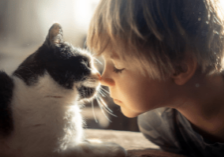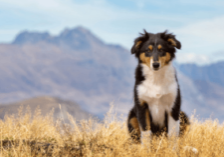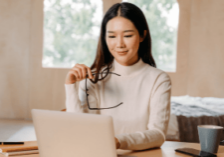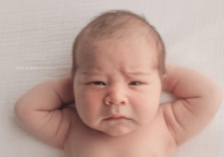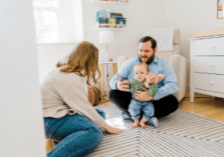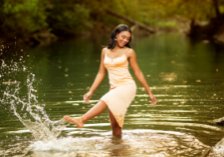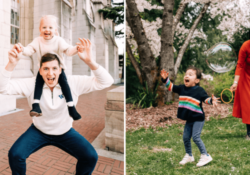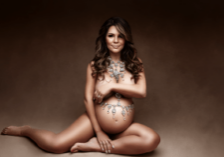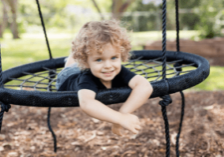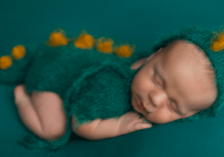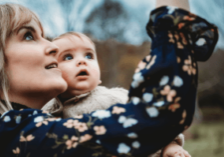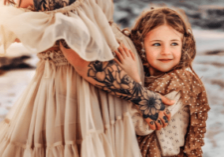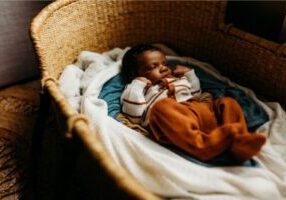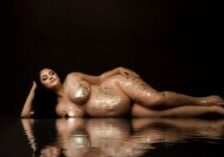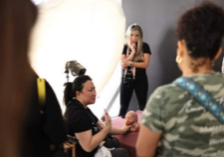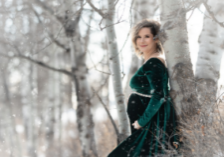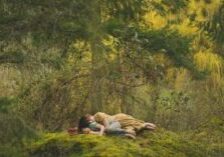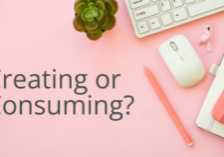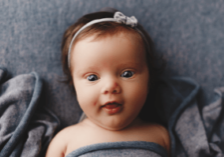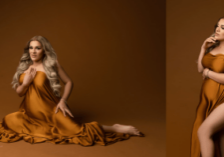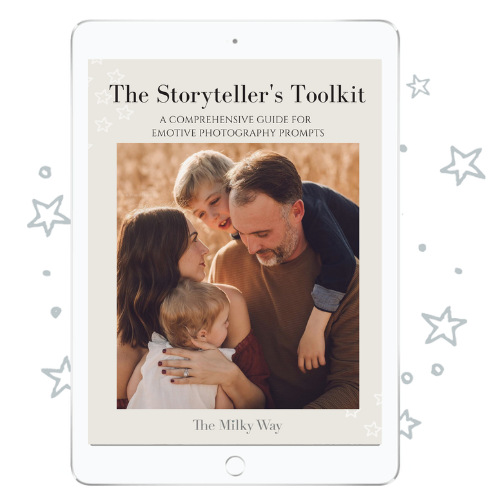Families, Fairy Tales, and Fine Art Photography: Capturing Timeless Images with Deborah Koch
When Deborah Koch first picked up a camera, she didn’t know she was starting a brand new career. She just wanted to document her family life with her husband and her two sweet kids. But, once she started diving into her photography education and discovering the creative possibilities of fine art photography, she fell in love with the medium.
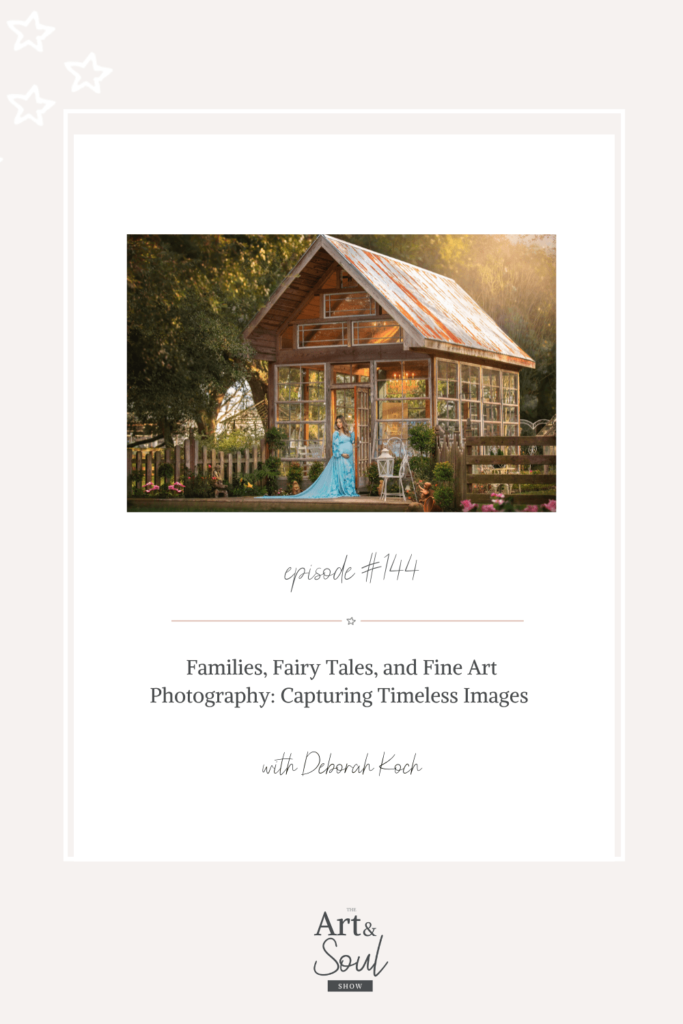
Today, she brings that joy and passion for creating timeless, gorgeous images to the clients she photographs through a thoughtful, collaborative process with her families. She’s kind enough to share the wisdom she’s gathered from her career of crafting beautiful images while never undervaluing her own fine art photography with us.
In this episode, Deborah shares how she balances her creative with her client work, practical advice on setting up a workflow that puts her families at ease, how she streamlined her culling and editing process to create magical images without getting overwhelmed, and why it’s so important to never lose sight of the value photographers bring to the world with the beautiful imagery we create.
What’s in this episode:
- [03:56] How Deb got started in photography and her journey to studying it more intensely
- [07:32] How Deb plans out her creative projects seasonally, instead of trying to force those projects during busy seasons
- [15:41] The workflow Deb has developed to help her families relax and to make sure she gets every shot without overshooting
- [22:42] How developing her confidence and restructuring her business allowed Deb to be able to create higher quality fine art photos without overdelivering
- [25:11] Why communicating and collaborating with her clients on styling and location play such a huge part in the works of art Deb creates for her clients
- [36:34] Why learning to value yourself and your art is key to finding an equilibrium within your work and personal life
If you’ve always wanted to dive into the magical world of fine art photography but felt overwhelmed by the intensity of the process, tune in to this episode with Deborah Koch.
SUBSCRIBE: iTunes | Spotify | Stitcher
Meet Deborah Koch
Deborah is originally from Brazil but has called the US her home for almost two decades. She is married to Superman and has two amazing children (that drive her bananas sometimes but make her the happiest mommy on Earth!)
She started photography when her kiddos were little (and all of a sudden, she noticed they were growing up too fast). She decided to buy a camera and started clicking every moment she could. When she realized taking a good photo was a lot more than just clicking a button, she started studying photography in depth. She was fascinated by the idea of turning her vision into reality and creating unique memories along the way. A few years later, she decided to turn her passion into a career and Deborah Koch Photography was born.
Each client is very special and unique to her and it’s a true joy to be able to freeze magical moments and turn them into art. She loves the opportunities she gets to photograph families and create life lasting memories.
Connect with Deborah
Deb’s Partner and Newborn Photographer, Paloma Schell
Deb and Paloma’s joint studio, Koch & Schell
Did this episode inspire you to craft your own magical fine art images? Check out these other episodes with Emily Williams, Shannon Squires and Joanna Booth
Transcript
[00:00:00] Deborah Koch And we’re going to leave something behind. We’re leaving a gift for the planet. We’re leaving a legacy. We’re leaving something that generations are going to look at. So I wish that everyone knew how important our jobs are like, we are creating memories. We are creating something that’s going to be seen like 100, 200 years from now.
[00:00:28] Lisa DiGeso Welcome to the Art and Soul Show, where we dove into heart opening chats on photography, business, life and that messy in between. I’m your host, Lisa DiGeso, a mom, a photographer and entrepreneur, and I’ll be sharing honest conversations and advice for photographers with insight on mindset, entrepreneurship and creativity. The goal of this podcast is for you to be able to gain insights and strategies that will get you real results. Because, let’s face it, having a photography business can be lonely, but it doesn’t have to be. This is the place you can go when you need a boost of encouragement, a kick in the pants and inspiration to pick up your camera. This is the Art and Soul Show.
[00:01:11] Lisa DiGeso Hello, my beautiful friends. Welcome back to the show. I am super excited to dove into today’s conversation with Deb Koch. She is a fine art photographer based in Houston, Texas. And if you haven’t checked her out on social media, I highly suggest you do. You’re going to fall in love with her work just as much as I have. Well, my friend. Welcome to the show.
[00:01:32] Deborah Koch Thank you. Thank you so much for having me. Hello, everyone.
[00:01:36] Lisa DiGeso So tell us who you are and what you’re passionate about.
[00:01:39] Deborah Koch I’m just a girl, a mom with a camera. But I do have a passion for recording memories and then for teaching. I love, love, love. Kind of making a difference in people’s lives. So whether if it’s in the family, creating some beautiful memories for them, for, you know, little girls to see how gorgeous they are, a mom, to see how beautiful she looks, growing a baby. And then I love watching my students grow and achieving success. So that’s me.
[00:02:09] Lisa DiGeso I love that. Now, you’re definitely a known fine art photographer. So can you tell us and explain how you define fine art photography?
[00:02:19] Deborah Koch I don’t know about no. And I think that’s just, you know, for me, it’s kind of like I’m not. So I’m going to tell you what I’m not. I’m not the photographer that would meet the client in the park and not knowing them and just pointing shoot at at them. So fine art to me has a little bit more of a custom feel to it. So I get to know my clients. We talk about outfit selections, we talk about what their house look like. We’re going to hang pictures, you know, what are we doing? What are we creating? So it’s all about, I think here their expectations and creating something magical for them. So I think the fine art in my mind is that fairy tale, that magic feel to it. Timeless images.
[00:03:07] Lisa DiGeso Yep, I love that. As a child, did you love fairy tale stuff? Like, was that something that you were obsessed with?
[00:03:13] Deborah Koch I don’t think I ever did.
[00:03:15] Deborah Koch No, it was never me like it was never my dream to meet the the princesses or go to Disney or live in the castle. I don’t know. I don’t know why. Now I have that feel to my to my photography. I think I enjoy timeless things. I’m never I have never been a trendy person, like clothing wise or, you know, what’s trendy in shows. I don’t watch TV much, so I tend to stick with classic, which I think, you know, the fairy tale is classic.
[00:03:45] Lisa DiGeso Mm hmm. I love that. Now, so how did you find your love of photography and specifically the finery genre?
[00:03:53] Deborah Koch I think it found me.
[00:03:54] Deborah Koch You know.
[00:03:56] Deborah Koch It’s kind of funny, my story, but I graduated college and my husband and I decided to start a family and didn’t go to college right away when I graduated high school. I’m from Brazil, so I moved to the U.S. and had to, you know, just jumping jobs to to make money and then decided to go to college. And then my husband and I met when I was in college and we dated for a while, got married when I graduated college and decided to start a family. So I actually graduated with a big belly. I was six months pregnant and no, actually, I wasn’t going to go for me interview or me thing like that. We decided that I was going to be a stay at home mom. But I always I’ve always loved being a stay at home mom and I love my kids so much, but I always kind of ressemble a little bit leaving a career, you know? So I decided to just have a project and bought a camera and I started photographing my own kids and next thing you know, I decided to really start. So for about two years, I just photographed them and I was, you know, studying, photographing Emmanuel, studying, lighting a little bit. But once I decided to turn that into a career, I took a year off and really studied. So I would cry like, you know, hours and hours and hours because I couldn’t figure it out. Photoshop and then because it’s not my first language. So everything I learned, I learned in English, but my first language is Portuguese. So for about a year, I would just sit. Down and try to get my vision out there. So I think that’s really what I found. The love for photography was when I actually sat down and study it.
[00:05:37] Lisa DiGeso I love that. Love that. So when you have a new idea, what is your process from taking it from that idea in your head to fruition?
[00:05:46] Deborah Koch I run my business as a business. So this is you know, this is my business. That’s how I make money. That’s how I print the money to my family. So when I have an idea, most of the times I do not put that idea out there with clients. I have like a motto or I’ll have my own kids. Or unless the client really comes to me for something totally different and, you know, gives me that creative, like, you know.
[00:06:13] Lisa DiGeso The free rein. Yeah.
[00:06:15] Deborah Koch Yes. But a lot of times I feel like because they have seen it in my in my website or because they have seen it in my social media, I feel like that’s what I need to present to them when they’re hiring me. So when I have an idea, most of the times I try to build up in that idea and then grab a motto, do a model, call, get my kid, go outside, try it out. And then I tried several times until it actually becomes something that I’m willing to sell and I’m willing to show off to my clients. And then I come up with like a new mini session or I styled session or, you know, something like that.
[00:06:54] Lisa DiGeso I love that.
[00:06:54] Deborah Koch It takes a while. I’m not like, Oh yeah, let’s do this. Yeah, sure. Let’s jump in a car and go to the park and do it.
[00:07:00] Lisa DiGeso Totally. That’s one thing I kind of struggle with a little bit is is that creativity of doing the personal projects, showing that, but then having like it’s very different. Like my fine art work is so time consuming. It’s such a project as you know. And then like my regular with my clients is typically like I have a process and I’ve been doing it for years, so I’m getting faster at it, but it is definitely a process. So I struggle with showing the fine art stuff and my clients expectations. So do you have any advice on sort of getting around that?
[00:07:32] Deborah Koch I mean, you know, in the head, you know, it’s extremely important to to have that time. And with being in business for so many years now, I kind of figure it out, the balance of my business. So January and February normally are very low months for me because everyone had Christmas cards done and it’s cold outside. So that’s when I tend to like to learn something new, to be creative, to invent something, to build a new prop or to to kind of let that out. And then around March, April, here in Houston, we have wildflowers. Everyone wants to be outside. The colors are popping in. And that’s a busy season for me. So April, May are busy months and typically I don’t be very creative around that time. And then June and July, it’s super hot. And if you access the most people like baby bird sizes, it’s so nothing else. And so I try to either travel with the kids or if I’m in town, I try to do a little bit more of studio work. I try to do something a little bit more creative in the studio. And then when I get back about August or September, it’s rain month. So I kind of have to allowed a little bit more time and flexibility my agenda, if I need to reschedule a session or something, it’s right back to school. People are thinking about fall and then October, November and December are like just crazy months. There’s no great for.
[00:08:58] Deborah Koch Me around that time. It’s the time to, you know, make money and be very consistent with my work and just, you know, do regular sessions, mini sessions and all of that. So I think I because I understand the the kind of the flow of my business now, I allowed myself to, you know, be go, go, go, you know, in busy mode. I call it survival mode season right now. And then I allowed myself to be more creative in the months that I know it’s not very busy for me.
[00:09:27] Lisa DiGeso I love that so much because I think instead of fighting the seasons of your business and the photography, you just kind of like lean into it.
[00:09:34] Deborah Koch Yes, I learn how and it works for me. You know, it may be different in different parts of the world or if you’re a, you know, newborn photographer where it’s not as seasonal as family photography is. So this is basically what works for me. And then when I accept projects and when I do teaching or mentoring or something like that, I try to, you know, fit that into my slow seasons instead of my busy seasons.
[00:09:58] Lisa DiGeso Now you share your studio with another pretty famous photographer, actually. So could you share a little bit how you and Paloma Schell got together?
[00:10:09] Deborah Koch It was so.
[00:10:10] Deborah Koch So crazy that I. I believe in in a guy up there, you know, that guy kind of sets our ways and has a destiny for us, but it was pretty crazy. So my friend Polly, that lives here in Houston, in fact, was one of my students to. She called me one day and she was like, Deb, Paloma is coming to Houston to do some workshops. Do you think you can host her? And to be clear, when you hold somebody, you know, you go to their workshop and help out. And I’m like, I don’t do newborns. I don’t photograph newborns. I, I know people and I can help. And I have a lot of students that would be interested and I have followers like I’m part of all of the groups. I can help her with marketing, but I don’t have the little outfits and the tables and that the stuff that that she needs, but I help her. So I got in touch with Leyonder, her husband, which he’s the one that does all of that, you know, behind the scenes part of her, her business. So we plan everything. So about the first day. So we added a second day, so about the second day. But it wasn’t going to be at my studio was going to be at a local shop in town because they had everything, you know, the lights, the beanbag, the batting, all of that stuff. So when we first and there’s this the funniest part. So when they first arrived, they were already at the studio at the shop, and I started talking to her. I was like, Hi, nice to meet you. My name is Deb and she looked at me like I had three heads. He’s like.
[00:11:45] Deborah Koch And I’m like. Why? And she’s like, You speak Portuguese?
[00:11:50] Deborah Koch And I’m like. Yes, I’m from Brazil. I was just like, Aren’t you Deborah Koch? And I’m like, Yeah, didn’t because I had gone to Brazil and I had been in like a big event over there and she’s like, Aren’t you the one that went to click family and spoke? And I was like, Yeah, that’s me. And Your Brazilian.
[00:12:10] Deborah Koch And I’m like. Oh my gosh, I’ve been talking to your husband for like three months, organizing your workshop and you did not know, like, do you guys not talk? It’s hilarious. And after that, I mean, we just became like really good friends. And she told me she was like, Look, I would like to come live in the U.S. Do you want to open a studio together? And I’m like, Hold on, let me catch my breath.
[00:12:37] Lisa DiGeso Like, Yes.
[00:12:40] Deborah Koch Yeah, you know. Oh.
[00:12:43] Deborah Koch From there it progressed. My business, my LLC actually requested her visa to come work here. You know, it was a bureaucracy with the embassy and all of that, and it was in the middle of COVID. And, well, COVID happened right then. So this was December 2019. And then when all of the papers she got approved for her papers in March and COVID hit, oh, oh, she couldn’t get an interview at the embassy anyway. Long story short, she moved here. We opened our studio together. It’s been a strong year and a half and I could not be happier.
[00:13:21] Lisa DiGeso I love that so much. So great. I think that’s just so cool. And because it’s just because you don’t even you do newborns, right? So you’re like, perfect.
[00:13:30] Deborah Koch It was like we met. We it was like the perfect marriage because I would do maternity and I’ve always had a love for maternity sessions, but I didn’t really have anyone in town that I could send my clients to go to, and then they would come back to me. My competition at a time was charging half of my price and they were really good, so I really never had anyone that could finish that cycle. So right now I do maternity and then she does newborn up to 11 months. And then when they do a year, oh, they do the cake smashes and then I proceed doing family photography.
[00:14:06] Lisa DiGeso I love that. That’s so great. Well, congratulations. That’s pretty awesome.
[00:14:11] Deborah Koch Thank you. And she’s such a go getter. You know, Lisa, she so great. Of course, when you start a partnership, you don’t ever know how it’s going to be. If you guys are going to get along, you know, the respect of the space and all that. And both her and Leyonder have been such an amazing joy to work with.
[00:14:30] Lisa DiGeso I love that. That’s so great. Yeah, we worked she worked with us. We did see I think she was the 2018 or 2017. She you taught for the Milky Way and she’s just a lovely human. She’s so great. I love that. So I love art. We’re going to go back to fine art because I really do love it and I love really creating only a few pieces per client. So can you share how you ensure you don’t overdeliver? Because as we know, fine art is really time consuming.
[00:14:59] Deborah Koch I like to tell my my clients and I tell my students that too. Like I am more I’m very control freak, so I am very detail oriented. The hair needs to be in the right place. I’ll stop, you know, and I’ll be like, okay, well, your hair needs to do this and you need to do this and you need to turn your shoulder this way or that way and things like that. So I think 90% of the time I’m preparing to shoot. I don’t shoot like 15 of the same pose or anything like that. So majority of the time I would do the fashion and then I don’t over shoot because I know in my head already what I need and I have a workflow that has worked for me. So can I share?
[00:15:39] Lisa DiGeso Yeah. Mm.
[00:15:41] Deborah Koch Okay. That’s something that I talk when I, when I do, you know, workshops and when I do teaching and all that because I think has worked for me. So it may work for, you know, people out there at home that, that get a little stop on what to do. So I start out with the whole family and the reason why is because the mom is always so stressed and she had looked at print racks and she has all of the perfect things and she’s nervous and she wants to show the world how her family’s perfect, right? Yeah. And then Daddy don’t ever want to be there. They want to be drinking beer, watching soccer or football, whatever, baseball, you know. And then the kids don’t know what’s going on, but they can feel the tense like Dad is tense because she doesn’t want to be there. Mom is tense because she knows that she doesn’t want to be there. But it’s important and the kids feel that.
[00:16:27] Deborah Koch So if I start out with the family pose, everyone relaxes because Daddy thinks it’s almost done. Mommy’s like, Ooh, I have that perfect picture to put it in my wall. And the kids don’t know what’s going on, but they are going to get ice cream if everything goes well and you know, everything’s going up because Mommy’s smiling and Dad is happy. So I start out with that and then I break up a little bit. I’ll do mom and the kids, mommy and each one of the kids that in the kids that in each one of the kids the kids together, each one of the kids like full body. And then I’ll do like a little bit more of like a close up headshot or three quarters where you can show like the real smiles, the personality, all of that. And then I’ll go back and do like a nice family pose with like everyone tickling each other or something more playful and all of that. And then I’ll finish with Mommy and Daddy together because chances are they haven’t done a photo since like their wedding or something like that. So I always try to finish with a little bit more romantic and they know it’s almost over and I’ll have them like looking at me and finishing with the little kiss. I love to do my downtown Deb, You know, and that is Mommy. I love that connection that it creates when they’re both relaxed and happy. So I already have in my mind probably about 10 to 15 poses, and that’s about what I deliver. And within those poses, maybe two or three combinations or two or three different, like maybe one smiling and one not smiling. And then the family photo, or maybe everyone looking at me and then looking at each other and then maybe tickling or something like that. So I do a variation of that, but that’s my workflow that I have in my mind. And typically my clients know that they’re not going to be getting a lot of quantity. They’re going to be getting quality.
[00:18:14] Lisa DiGeso Quality, yeah, I love that.
[00:18:16] Deborah Koch That’s what I work for.
[00:18:17] Lisa DiGeso I think a lot of the time I get stuck because I shoot really quickly and I give a lot of prompts. So I’m moving things all the time and tweaking things. It’s like, turn your head, give her a kiss, do this higher, lower. So I’m very directive. So I end up with these massive galleries and then I shoot myself in the foot because I can’t call them. I’m just like, I like this one and this one and this one and this one and this one. Even though they’re like pretty darn the same.
[00:18:43] Deborah Koch Similar. So.
[00:18:44] Lisa DiGeso So do you have any tips on like culling?
[00:18:46] Deborah Koch Yes, I like to give them a variety, but not to be overwhelm. My galleries, they come the packages that I offer are 15, 20 and 30 images. Not that they couldn’t purchase anymore. I have had had clients, in fact, last week chose 40 images from her gallery. But I tried because I don’t want them and I don’t want to be editing 100 images from the same gallery gets boring and it gets.
[00:19:12] Lisa DiGeso Boring and that’s what happens. I get bored.
[00:19:15] Deborah Koch Yeah, I prefer that they come often, but I prefer that they choose. I think 20 is a good number for my work. Obviously it’s more money if they choose 30, but I prefer that they come in, choose 20 images two or three times a year, then they choose 60 images from the same gallery. So in order to do that, I tried to do one or two variations of each one of those poses and that setup combination that I told you. So typically my gallery comes with like my proof gallery comes with about 60 images and then from there they can reduce to 15, 20 or 30 images. So that’s what I try to do.
[00:19:55] Lisa DiGeso So with the 60 images, what you’re fully shooting?
[00:19:58] Deborah Koch That’s what I deliver for them to choose from. Yes, I’m okay. Maybe 120 to 150 and then I separate. And then one thing that I do, Lisa, is because I photograph with the 200, you know, and I’m very far from a subject, I may take three or four off the exact same image, but I toggle more focal point to each one of your faces just to make sure that everyone is sharp and crisp and all of that. But I’m not going to be sending them all those five or six. Images, I would send one or two of that selection. So I have extra if I need to and it’s extra insurance. So I may have 150 images that I shot in a session, but they don’t need to see all of them. They only need to see about 60 or 75 images.
[00:20:43] Lisa DiGeso Yeah, I love that. I know I’ve been a chronic over shooter since 2010. Like my average newborn gallery, I swear is like 500 newer. I know. Stop it.
[00:20:56] Deborah Koch And they don’t even move, right? Know.
[00:21:01] Lisa DiGeso I know. I make my own worst enemy. It’s hilarious.
[00:21:04] Deborah Koch I don’t want to be, like, very confusing for them because the longer they they take, you know, to select the images, the more time passes by and they’re less likely to select a lot of images. So I try right away my processes. I photograph a session within a day or two. I tried to send them their proof gallery, you know, and I tried to have them select within two or three days. So that way I can have my editing consistent and I can have, you know, my workflow going on.
[00:21:34] Lisa DiGeso I love that. So you send them a self proof gallery.
[00:21:37] Deborah Koch I do. And I know.
[00:21:38] Lisa DiGeso Awesome.
[00:21:39] Deborah Koch I know.
[00:21:40] Deborah Koch Or, you know, skeptical about it. My approved gallery in I have a big watermark, an entire photo that has proof, proof, proof. So here is the frame. And it says proof, proof, proof. There’s no way of them cropping or taking them off, removing it or anything like that. But I feel like it’s important for family photography. I feel like it’s important for mommy to paint the real connections. The real smiles, the real personality. You know, that she wants to look. 20 years from now. She’s the one looking at that image, not me.
[00:22:13] Lisa DiGeso Oh, I love that. That’s a really neat perspective, because that’s that’s one thing that I’ve always noticed is the ones that are my favorite images are not necessarily the favorite images of my clients.
[00:22:23] Deborah Koch Exactly.
[00:22:23] Lisa DiGeso So that’s really interesting. I like I like that.
[00:22:26] Deborah Koch That’s how it started. I used to, you know, when I first started photography, I used to select and then I think just like most of us over delivering because I wasn’t very confident in my work. So I would promise 20 images and then I would deliver sixty.
[00:22:42] Deborah Koch And.
[00:22:42] Deborah Koch You know, and then they would ask for more. They’ll be like, Well, but how about that one pose or this or that? So I decided to restructure my business in a way that it would work for me. And because, like you mentioned, fine art is so time consuming. It takes so long to edit each one of the images. I make it a priority if they make them a priority. So if that’s their favorite, if they make it important enough for them to select and purchase it, I make it important enough for me to take my time editing that image and make it absolutely perfect for them.
[00:23:14] Lisa DiGeso I love that. Do you ever run into a situation where they’re like, Well, can you just give us the ones that aren’t edited to.
[00:23:19] Deborah Koch Oh, yes, all the time.
[00:23:21] Lisa DiGeso And so what do you do in that situation?
[00:23:23] Deborah Koch No.
[00:23:24] Lisa DiGeso Yeah, yeah.
[00:23:27] Lisa DiGeso Because.
[00:23:27] Deborah Koch It’s not Representation of my work. You know, I go to a restaurant and asking for raw food. It’s not really example.
[00:23:35] Lisa DiGeso I’m yeah, exactly. I love that.
[00:23:38] Deborah Koch They get the egg shells just because I collect them. You know, you can’t do that. You’re going to have the omelet, you’re going to have the final product. So that’s what I tell them. I’m just like, look, one, you can’t really open it because you don’t have Photoshop in your computer. You can open a raw image, you know, you need a specific program and to that’s not the best representation of my work. So I prefer that you have ten images that you absolutely love, then you have 100 images that you barely going to look at it because they all look the same.
[00:24:07] Lisa DiGeso Or you’re just gonna throw an Instagram filter on and I’m going to die. And so you’re.
[00:24:11] Deborah Koch Going to do make it happen with your edited images and not edited. You can’t, you know.
[00:24:16] Lisa DiGeso So now it ends up on Instagram out there.
[00:24:22] Deborah Koch You know, that’s.
[00:24:23] Deborah Koch Not what what I want people to see. I want them to see the final image. And it’s such a big difference to me that perhaps if it was a different business model where maybe I did like a wedding and I batch edit in Lightroom, it would have been different. But it’s such a big difference from my raw image to my final product that I think now my clients understand. So it’s been a very long time and it’s in my contract, it’s in my website. I talk to every single client on the phone and explain them, the process and all of that. So it’s been a very long time, but every now and then I do get like, Oh, where are we going to throw it away? Can I please have it? No.
[00:25:02] Deborah Koch No, no.
[00:25:05] Lisa DiGeso I love that. So how do you feel styling, light and location play into the work that you create?
[00:25:11] Deborah Koch Huge, huge, huge. Location. I always talk to them like, what kind of lifestyle do you have? Are you guys more urban people? Do you enjoy going to the park? Do you go for bike rides? Do you enjoy hiking? You know, and a lot of times it takes. I’m a while to think like, oh, let me think. And then the second thing about location is how is your house decorated? Like, how is it everything? Why Pottery Barn thing, you know? Or do you have darker pieces? Do you? Is it more moody? Is it more modern? The reason I do that I’ll share with you. I one time I had this like very specific look in my mind and I hired an amazing photographer to take those gorgeous pictures for me because I wanted, you know, my family in a dark, moody set, and she has amazing light and everything. And then I realized that where I was going to put that photo in a big canvas in my house was a dark wall, and it didn’t really go with it because I was like, Now I have a dark photo with a dark wall. So I always ask them like, How is your decoration? Where are you going to put your one piece? And at that time I’m telling them, Look where you’re going to get a big piece. Where are we putting that big piece in your house? So I have them think about all of that and then I suggest locations based on that. So if they want very light and airy, well, let’s go to the beach or let’s go to Bluebonnets or a field with flowers or something like that. And if they want dark and moody, all my house, you know, I have dark wood floors, dark furniture. Okay, well, let’s think about like maybe the forest or something with beautiful back lighting with golden hour or something like that. So location plays a big important.
[00:26:56] Deborah Koch And then of course, what do you want to portray? What kind of mood are we going for? What do you envision? So I always send them to my website and have them take a look at some of the locations. Now, granted, it could be like because I’m photographing a client out of town or because I’m teaching a workshop or because, you know, I travel. So I do let them know like, look, I travel quite a bit. So if you see something that doesn’t look like it’s Houston, perhaps it’s not, but something similar for us to go. So I do give them the warning ahead of time. But I think that that setting the mood for for the session, the location has really a big impact in the lighting, obviously. I mean, extremely important for outdoor photography for a studio, too, obviously. But for outdoor, if you don’t have good lighting, you won’t have beautiful quality image, you know. So I always think about like, where are we going first? How many people are going to be in the session? Are they changing outfits or are they not? How old are the kids? Because, you know, one year old me take me a little bit more time then a seven or eight year old. Where is the location? Is that do I have filter light? Is that a park where I can go a little bit earlier and start like under the trees and then maybe walk a little bit more into a more open area towards the end of the session, you know? And then I always have to consider if I think that my ideal light’s going to be at five, I always have them come in at like four, three, because maybe they’re stuck in traffic. Maybe they need to stop because baby threw up in the car. Maybe they need to use the bathroom. Maybe it’s going to be a big cloud and I’m going to lose light a little bit faster and all of that. So I always think of light and I never just show up to location and just start photographing. If it’s a location out of town and I can not drive there the day before in the same time that the session is going to be or something like that. I at least get there 30 minutes before and take a look and have like a plan. In my mind. I never just show up in like, Oh, we’ll figure it out that I, like I mentioned earlier that I’m a little control freak.
[00:29:05] Lisa DiGeso I love it. It’s how you get the best result. You have to be.
[00:29:08] Deborah Koch Yes, because I want to know what I want to show to my client that I understand what I’m doing. Well, ma’am, we’re going to be right over here because the lighting is going to be hitting your face and we’re going to be able to show lots of, you know, face expressions and futures or I’m going to put you sideways because we’re going to have beautiful rim light and it’s going to show, you know, your gorgeous blond hair and it’s going to highlight your belly. So it’s always important to show them what you’re doing. And then, you know, the end result that you’re expecting from that, it makes you look professional and then it sets expectations so you don’t have well, let’s try this and let’s try that. No, we’re not trying. We’re doing it because I know what I’m doing. So lighting is extremely important. And then the outfits one needs to be comfortable because if you’re not comfortable in the outfit, they’re not.
[00:29:55] Lisa DiGeso It shows.
[00:29:55] Deborah Koch To feel good. Exactly. They’re going to be tense and all of that. And then too, it needs to be something that they can see themselves in. I can, you know, just get somebody and be like, oh, this is what you’re going to wear and need to understand a little bit of what they enjoy, what the features in their bodies are that they’re proud of, and things that, you know, especially us moms, things that we want to try to hide. And if they’re going to have long hair, we’re going to be able to hide the arm. Do they have any concerns with their body. So once I learned a little bit more about their concerns and then what they want to show, then I’m able to make a few selections or, you know, I have a huge closet in my studio, so my full clients, full session clients can come to the studio and they can borrow something from my studio if they prefer to purchase something we are very in touch with. Like I send links to them, they’ll come to the studio and show me what they got. So it’s extremely important. And then plus I feel like that sets me apart from the other photographers because I’m able to, you know, take a little bit of stress out of their life and then it creates a better experience for them. So they they keep coming back. They’ll tell their friends like, oh my gosh, go to her. She has all the outfits or she’ll tell you, you know, what to wear. She’ll work with you. It’s not just, you know, meet me there and let’s see what we can do.
[00:31:25] Lisa DiGeso So how often are you buying new outfits?
[00:31:28] Deborah Koch More often than I would ever admit.
[00:31:31] Deborah Koch I know and more often than I sell some of them. You know, I know.
[00:31:38] Lisa DiGeso My I’m a hoarder. I can’t help it. I’m a hoarder. I pretty much have every dress I’ve ever purchased and I have a problem. Like I have a whole room full of outfits that I probably should start liquidating. It is so funny.
[00:31:50] Deborah Koch I don’t know what you’re talking about. I do work with a few boutiques though, in like trade basis, and for people that are listening at home that are starting photography and feel like, well, I can’t go and spend, you know, $20,000 in outfits. A couple of suggestions are you can always create events like I’m doing a build my closet event so clients can purchase something from a link and then you can create like Amazon Wish List or you can create wish lists and know different boutiques and then say, Hey, purchase this and I’ll give you a print credit and I’ll get the dress. Or you can get with a local cemetery and say, Hey, I have these two or three gowns that I would like for you to sew it for me. And, you know, I’ll let’s work together, I’ll pay your rates or I’ll provide photos and you give me a discount or something like that. So there are different ways of building a closet without having to spend thousands and thousands of dollars. But that definitely having you’re, not only having your closet, not only keeps your work consistent because you buy stuff that you like and then you show stuff that you buy that you like, and then they come to you because you have that, but also kind of, you know, allows you to offer one step more and be one step ahead in your in your process of session. And your clients will come to you for that, for sure.
[00:33:17] Lisa DiGeso So you ready for our lightning round?
[00:33:19] Deborah Koch Ooh, let’s do it.
[00:33:21] Lisa DiGeso Okay. Coffee or tea?
[00:33:22] Deborah Koch Coffee.
[00:33:24] Lisa DiGeso What do you like to cook the most?
[00:33:26] Deborah Koch I don’t like to cook.
[00:33:30] Lisa DiGeso Order. Take it. What do you like to order takeout from or the most?
[00:33:33] Deborah Koch I do cook.
[00:33:34] Deborah Koch But I don’t enjoy.
[00:33:37] Deborah Koch A frozen pizza that I love.
[00:33:41] Lisa DiGeso It was the last thing you did for yourself as an indulgent travel. What did you want to be when you grew up? When you were a kid?
[00:33:50] Deborah Koch I always thought I was going to be an architect.
[00:33:52] Lisa DiGeso Oh, interesting. What’s the go to song that lifts you up when you’re feeling down?
[00:33:59] Deborah Koch Because I’m happy.
[00:34:04] Lisa DiGeso What three things do you want to be remembered for?
[00:34:07] Deborah Koch I want. I want to be remembered for a kindness. You know, I always think that when I die, I would like for people to come to my funeral and tell my kids, like, your mom was kind to me. Your mom made a difference in my life and your mom was a good person. So I want to be remembered for that, for doing the right things.
[00:34:26] Lisa DiGeso Do you have any personal projects going on right now? And if you do, what is it?
[00:34:30] Deborah Koch Oh my goodness. How many can I mention?
[00:34:34] Lisa DiGeso How many of you like?
[00:34:37] Deborah Koch I have a personal project and I’ve never told anyone that besides my family, so I’ll tell you. But I would like to visit 50 countries before I turn 50.
[00:34:49] Deborah Koch I love that.
[00:34:51] Deborah Koch So that’s that’s the project that I have been working on, I guess because I grew up in another country and I have lived in the U.S., I have lived in Canada as an exchange student. And because I guess here in Houston, we have people from so many different cultures. I’m very sensitive to cultures and I love going to new places and getting to know people and trying the food and listening to the music. So I like to expose my kids to that as well. So I would love to to visit as many countries as I can and show them how people live different and yet happy. And we don’t have it all, but we have to be grateful for what we have.
[00:35:29] Lisa DiGeso What would be your dream food? Where and why?
[00:35:33] Deborah Koch Oh, well, in Paris, with my daughter in the big four fin dress. I’m very close to make that happen.
[00:35:40] Deborah Koch So I love.
[00:35:43] Lisa DiGeso That when you feel stuck, where do you draw inspiration from?
[00:35:47] Deborah Koch I think God and you know, I just close my eyes and I say, just to show me the way.
[00:35:53] Lisa DiGeso Yeah. What do you wish more photographers knew.
[00:35:56] Deborah Koch That we are very important. We have a very, very, very important job. We don’t value ourselves like we should. We’re going to die. Everyone’s going to die and we’re going to leave something behind. We’re living a gift for the planet. We’re living a legacy. We’re living something that generations are going to look at. So I wish that everyone knew how important Earth jobs are like. We are creating memories. We are creating something that’s going to be. Like 100, 200 years from now.
[00:36:31] Lisa DiGeso What advice do you have for someone just starting out.
[00:36:34] Deborah Koch Within that is value yourself like invest in education, learn. Be good at what you do, you know. And then once you once you learn, you’re going to build confidence. And when you’re confident, you’re going to value your work. And when you value your work, your clients are going to value your work. So I think it’s all like a big old ball, a snowball. And a lot of times when you start out, if you don’t have the proper education or the proper knowledge, you feel less important than somebody else. And then you feel like you’re going to have to deliver overdeliver or undercharged or, you know, work crazy hours and then, you know, you lose that balance. You ended up working too much and then you leave some gaps at home with your spouse or with your kids or within your life health. And and that’s that’s not cool.
[00:37:30] Lisa DiGeso Yeah, I agree. I learned that one the hard way.
[00:37:37] Deborah Koch That’s what I wish I started this theme.
[00:37:40] Lisa DiGeso So where can our listeners learn more from you?
[00:37:43] Deborah Koch They can go to my website. I have two websites. Most of my outdoor work is at www.DeborahKochPhotography.com and then cook is K-O-C-H and I also have Koch & Schell Studio. So if you type in family photography Houston dot com you’ll be able to find us. And that’s my indoor work with Paloma. So all of my studio work is in there with all my studio work and we’re in social media as well. So Deborah Cook photography on Instagram and Facebook and then cooking show studios on Instagram and Facebook.
[00:38:19] Lisa DiGeso So I love to end my interviews with this last question. And it is what are you curious about or artistically curious about right now?
[00:38:27] Deborah Koch Oh, we’re ending.
[00:38:31] Deborah Koch I know. Well, we.
[00:38:34] Deborah Koch Told you in January and February. I like to work on something, you know, learn something or a personal project or something. I think this coming year I’m going to try to learn a little bit more about landscaping photography, because I enjoy traveling so much. I thought that would be such a good fit, but I don’t know anything about it right now. I photographed with a 200, which I know it’s.
[00:38:56] Deborah Koch Not appropriate for me and.
[00:38:59] Deborah Koch That’s all I know is that I don’t have the right equipment. But other than that, I would love to learn something new.
[00:39:04] Lisa DiGeso Well, thank you for joining me today. Deb.
[00:39:07] Deborah Koch Thank you so much. Thank you. I’m so excited to be a part of this wonderful family. I have been watching you for such a long, long, long time and I’m very excited to have a project with you coming up, can we talk a little bit about. Yes.
[00:39:22] Lisa DiGeso So you’re going to come teach for Dove? Did it? I’m done. The online new moon retreat. Yeah. We’re so excited to have you. Do you want to share what you’re teaching a lot?
[00:39:32] Deborah Koch Yes. So I’ve been doing downtown sessions for a while, and it’s it’s so wild because every time I post any downtown many sessions, it sells out in like seconds. And a lot of people ask me like, what are you doing? Are you in the middle of the road? Do you close the road or they’re in not cars? Do you get run over? So I’m actually teaching you guys about maternity in downtown Houston. And yes, we’re going to be in the middle of the street. And yet cars do pass by and never been run over by any cars. And I am going to share my process for editing those images, which I think makes a big difference. So share how I add extra sparkles to my images. A lot of people ask me if I have outdoor lighting, like if I use off camera flash, can you imagine me like running after it’s oh.
[00:40:25] Deborah Koch Gosh, it’s like I’m.
[00:40:27] Deborah Koch 86 with.
[00:40:28] Lisa DiGeso Your 200.
[00:40:30] Deborah Koch So you guys how I add it and I create that magic in post-processing.
[00:40:35] Lisa DiGeso I love that. Oh my beautiful friends. Thank you so much for tuning in. I hope you adored this conversation just as much as I did. And my beautiful friends, I am sending you so much of my light and love today and every single day. We’ll see you next time.
share the love
[Sassy_Social_Share]
recent
Podcasts
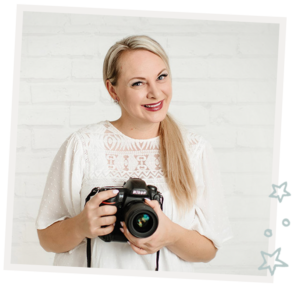
I'm
Lisa DiGeso
I’m on a mission to create uplifting online experiences for photographers ready to elevate their art, their business and their mindset.(...and have fun along the way!)

